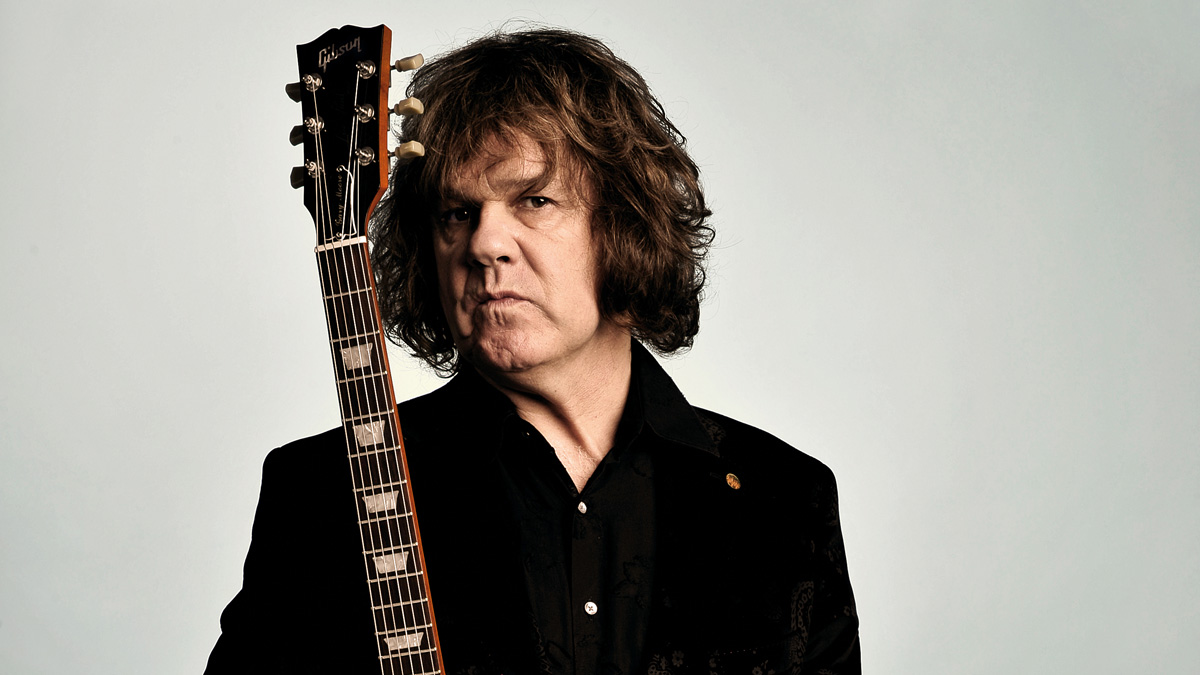"I was angry. All the work we'd put in and he just stepped out the back door?” Scott Gorham on Gary Moore's third and final run that left Thin Lizzy rudderless in the middle of a tour
Gorham says he was "thrilled" by Moore's decision to join, but the honeymoon was brief. The divorce was abrupt — and final

Of all the guitarists who played in Thin Lizzy, Scott Gorham had the longest run. He served during the band's classic years, from 1974 to 1983, and again in the modern era from 1996 to 2019.
Over his initial run, Gorham was paired off with six-stringers that included Brian Robertson, Gary Moore, Snowy White and John Sykes. But only one of those players took him from ecstasy to anger: Gary Moore, whom he forged a partnership with in 1978 and who would leave the band acrimoniously just a short time later.
Moore had three stints in Lizzy. He replaced founding guitarist Eric Bell in 1974, but lasted just a few months. Three years later, he came to the band's aid when a hand injury sidelined Brian Robertson.
But his most fruitful era came in '78 when he stuck around long enough to sprinkle his magic on the ninth album, 1979's Black Rose: A Rock Legend. At the start, Gorham was excited to be working with a player of Moore's talent.
“I was thrilled that this guy was gonna come into the band, because I knew what he could do,” he tells Guitarist. “I knew that, once again, here was a guy I could feed off and learn some really great shit off of him. Gary was one of those absolute natural-born guitar players.”
Gorham had joined Thin Lizzy in 1974, pairing up with Brian Robertson to give the group its celebrated twin-guitar attack. The two guitarists had a fruitful partnership during which they defined Lizzy's signature guitar sound, as heard on hits like "The Boys Are Back in Town."
But Robertson left the band in July 1978 due to irreconcilable differences with bassist and singer Phil Lynott. Moore returned to the fold, and Gorham says their connection was instant. Both were Les Paul players — Gorham had treated himself to a new LP after securing the Lizzy gig, when his Japanese knock-off fell apart during his audition — and Moore, at that time, was toting Peter Green’s infamous Greeny.
All the latest guitar news, interviews, lessons, reviews, deals and more, direct to your inbox!
“Every once in a while, he had an SG he would pull out,” Gorham details. “But 90 percent of the time it was the two Les Pauls. Pairing Les Pauls works because they both have similar sounds. The difference comes from the way the player attacks the strings.
“Gary was great with that. He'd attack the guitar with different velocities to bring out different tones. He was so inventive. I remember, he came up to me one day and said, 'Check this out — doesn't this sound like bagpipes?'
“I was like, 'Goddamn, it does! What are you gonna use that for?'
“And he said, 'Nothing, I just wanted to see if I could do it.'”

The album they worked on together, Black Rose: A Rock Legend, birthed the Thin Lizzy anthems “Waiting for an Alibi” and “Do Anything You Want To.” That, in turn paved the way for an iconic appearance on The Old Grey Whistle Test, where the Gorham-Moore partnership gave “Don’t Believe a Word” a rampant, ear-splitting redressing.
But the honeymoon period could only last so long. Moore left the band abruptly in July 1979, in the middle of a U.S. tour later that year.
“I think, towards the end there, Gary really did want to play all the guitars,” Gorham reflects. “He just wanted it to be him and him alone. And y'know, that would have been fine. Both Phil and I would have been cool: ‘This is not a jail sentence. No band is.’
“But you gotta quit at the right moment, and Gary did the worst thing any band member can do.
“I was angry, man. You just don't do that. All the work we'd put in and he just stepped out the back door? Like, what the fuck, man?”

Moore's third entrance to Thin Lizzy came just as he was forging a solo career. Released in 1978, his solo debut, Back on the Streets, proved a success, particularly with the romantic blues ballad and closing track "Parisienne Walkways," and it gave him the confidence to go his own way.
Their less-than-amicable parting of ways saw Gorham give Moore the cold shoulder until Lynott's death in 1986 softened his edge.
"In the ensuing years, Gary kept trying to apologize to me," he reveals. "When we did the tribute to Phil in Dublin, he pointedly asked me to come over, and he just couldn't apologize enough for quitting the tour."
"So I said, 'Well, it was a dick move. But hey, you've apologized and I forgive you — let's just walk away from that one.' And we were friends after that."
Scott Gorham is currently recovering from a health condition that saw him undergo three bouts of surgery, during one of which he briefly died on the operating table.
Meanwhile, a campaign has been launched to erect a statue of the late Gary Moore in Belfast, Northern Ireland. A local politician believes “he deserves to be honored in his home city.”
A freelance writer with a penchant for music that gets weird, Phil is a regular contributor to Prog, Guitar World, and Total Guitar magazines and is especially keen on shining a light on unknown artists. Outside of the journalism realm, you can find him writing angular riffs in progressive metal band, Prognosis, in which he slings an 8-string Strandberg Boden Original, churning that low string through a variety of tunings. He's also a published author and is currently penning his debut novel which chucks fantasy, mythology and humanity into a great big melting pot.


